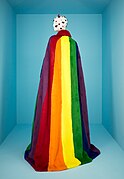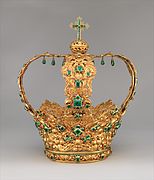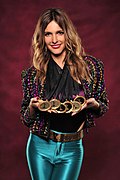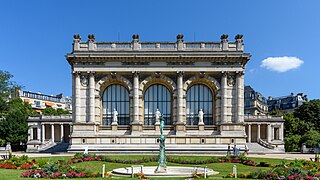The Fashion Portal
 | |

| |
Fashion is a term used interchangeably to describe the creation of clothing, footwear, accessories, cosmetics, and jewellery of different cultural aesthetics and their mix and match into outfits that depict distinctive ways of dressing (styles and trends) as signifiers of social status, self-expression, and group belonging. As a multifaceted term, fashion describes an industry, styles, aesthetics, and trends.
The term 'fashion' originates from the Latin word 'Facere,' which means 'to make,' and describes the manufacturing, mixing, and wearing of outfits adorned with specific cultural aesthetics, patterns, motifs, shapes, and cuts, allowing people to showcase their group belonging, values, meanings, beliefs, and ways of life. Given the rise in mass production of commodities and clothing at lower prices and global reach, reducing fashion's environmental impact and improving sustainability has become an urgent issue among politicians, brands, and consumers. (Full article...)
Selected article -

Traditional Inuit clothing is a complex system of cold-weather garments historically made from animal hide and fur, worn by Inuit, a group of culturally related Indigenous peoples inhabiting the Arctic areas of Canada, Greenland, and the United States. The basic outfit consisted of a parka, pants, mittens, inner footwear, and outer boots. The most common sources of hide were caribou, seals, and seabirds, although other animals were used when available. The production of warm, durable clothing was an essential survival skill which was passed down from women to girls, and which could take years to master. Preparation of clothing was an intensive, weeks-long process that occurred on a yearly cycle following established hunting seasons. The creation and use of skin clothing was strongly intertwined with Inuit religious beliefs.
Despite the wide geographical distribution of Inuit across the Arctic, historically, these garments were consistent in both design and material due to the common need for protection against the extreme weather and the limited range of materials suitable for the purpose. The appearance of individual garments varied according to gender roles and seasonal needs, as well as the specific dress customs of each tribe or group. The Inuit decorated their clothing with fringes, pendants, and insets of contrasting colours, and later adopted techniques such as beadwork when trade made new materials available. (Full article...)Core topics -

Featured picture -

A photo of two maiko (apprentice geisha), with the typical make-up clearly visible, leaving portions of the nape uncovered. This is done to accentuate what is a traditionally erotic area. The white face make-up is supposed to resemble a mask, and a line of bare skin around the hairline helps create that illusion. Established geisha generally wear full white face makeup characteristic of maiko only during special performances.
Did you know... -
- ... that the pink dress (pictured) which Marilyn Monroe wore in Gentlemen Prefer Blondes (1953) was emulated by Madonna in her video to "Material Girl"?
- ... that fashion model Frankie Rayder has posed with her sisters Molly and Missy for Gap holiday ads?
- ... that Nonnie Moore, a woman who had been fashion editor at Mademoiselle and Harper's Bazaar, was hired by GQ in 1984 in a move that was called "an odd choice, but... was actually the perfect choice"?
Selected biography -
Kylie Ann Minogue AO OBE (/mɪˈnoʊɡ/; born 28 May 1968) is an Australian singer and actress. She is the highest-selling female recording artist from Australia, having sold over 80 million records worldwide. She has been recognised for reinventing herself in music as well as fashion, and is referred to by the European press as the "Princess of Pop" and a style icon. Her accolades include two Grammy Awards, four Brit Awards and eighteen ARIA Music Awards. In 2024, Time named her one of the most influential people in the world.
Born and raised in Melbourne, Minogue first achieved recognition starring as Charlene Robinson in the Australian soap opera Neighbours (1986–1988). She began her music career in the late 1980s, releasing four bubblegum and dance-pop-influenced studio albums under PWL. By the early 1990s, Minogue had amassed several top ten singles in Australia and the UK, including "The Loco-Motion", "I Should Be So Lucky", "Especially for You", "Hand on Your Heart" and "Better the Devil You Know". Taking more creative control over her music, she signed with Deconstruction Records in 1993 and released the albums Kylie Minogue (1994) and Impossible Princess (1997). (Full article...)General images
Lua error: No content found on page "Women's beachwear fashion".
More Did you know (auto generated)

- ... that during the Second World War, the British government's campaign Make-Do and Mend encouraged the public to fashion men's clothes into womenswear?
- ... that the clothing tags for Alexander McQueen's first collection, Jack the Ripper Stalks His Victims, had McQueen's own hair encased inside?
- ... that Carlisle miser Margery Jackson, who chose to live like a pauper, possessed a fine court mantua?
- ... that fashion journalists joked that it was "a miracle" that no models fell while walking the runway in the 12-inch (30 cm) armadillo shoes designed in 2010 by Alexander McQueen?
- ... that the New York City-based fashion label Sandy Liang is inspired by grandmothers in Chinatown, and often features Liang's own grandmother as a model?
- ... that Malika Louback believes her three engineering degrees make her a better fashion model?
Selected quote -
Related portals
Topics
Featured content
Categories
Things you can do
- Fill out the red links on Portal:Fashion/Selected anniversaries
Wikimedia
The following Wikimedia Foundation sister projects provide more on this subject:
-
Commons
Free media repository -
Wikibooks
Free textbooks and manuals -
Wikidata
Free knowledge base -
Wikinews
Free-content news -
Wikiquote
Collection of quotations -
Wikisource
Free-content library -
Wikiversity
Free learning tools -
Wiktionary
Dictionary and thesaurus




































